When talking to artists at conventions and in-person events, the questions I receive most often are about my use of acrylics. It is about time I put that information in writing!
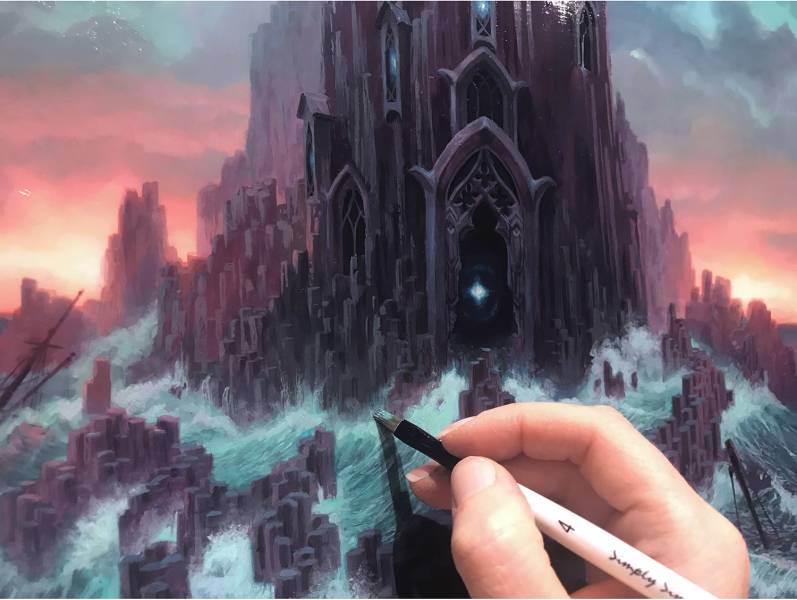
Find Part 2 here.
Acrylics: Working Time
Drying occurs when the water in the paint is drawn out via evaporation, and the quicker the evaporation, the faster it dries. It is a simple and a small thing once you have it figured out and working for you, but dry time can be the hurdle that prevents someone from starting at all. There are many factors we can manipulate to increase and occasionally decrease the working time for our paint. When they all work together, we have a surprising amount of control.
Surface Absorbency
If you’ve ever put a brush wet with ink, watercolor, or similar to an absorbent paper, you’ve felt the liquid be pulled from the brush. Even a purely digital artist has dripped coffee or tea on a sheet of paper and seen it flatten and spread. Once it has absorbed, there’s no wiping the color away. In contrast, spill a little bit of water on a non-absorbent surface and the water drops will sit as little beads atop it.
We’re not painting with water, but the water in the paint will behave the same way. Use a less permeable substrate to trap the water in the paint as long as possible and keep the paint workable.
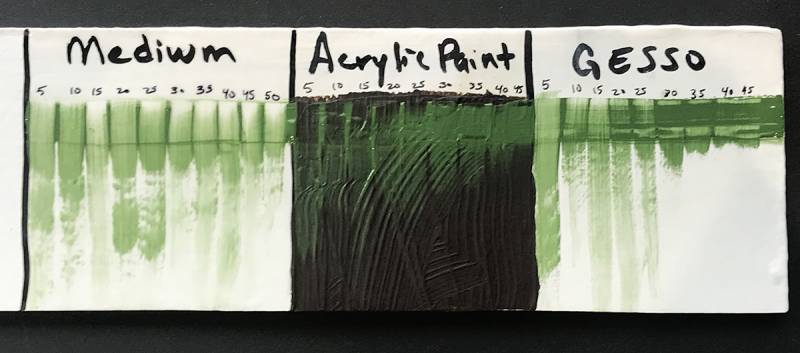
The paint is Golden OPEN, an acrylic with retarder in it…more on that below.
Since I work on wood, this example was done with a stroke of paint across gloss medium, a thick layer of dry paint, and gesso. Every 5 minutes I took a damp, squeezed-dry brush and made a single downward stroke to see how dry the paint had become. Gesso, which contains chalk, gypsum, or similar, is the most absorbent of the three and a the strokes showed a noticeable decrease in workability within the first half hour. The paint over gloss medium, however, was workable for over 50 minutes. If you’re painting with medium- to high-viscosity paint, I recommend a substrate that absorbs very little, like the gloss medium. However, if you intend to water down your acrylics like one might do with gouache or watercolor, stick with gesso or something more absorbent like watercolor paper. Water-thinned paint needs an absorptive surface or else it will bead and streak. You’ll sacrifice dry time, but you’ll save yourself frustration.

When the test was done, I waited another 5 minutes and brushed the whole area to see how each behaved at one hour. There really is no contest here!
Paint Retarder
A retarder is a substance, often something the artist adds to the paint, that slows the drying time of the paint by slowing evaporation. Most use glycerin or glycol, both of which dissolve in water and are safe to have around the studio…they’re used in foods, medicines, and skincare items for the very same purpose- moisture retention.
All of the professional acrylic brands make some kind of retarder, glazing medium, or similar, which can be mixed into the paint on the palette. However, my favorite product is Golden’s OPEN line of paints, which are heavy body paints that come with the retarder already mixed in. Adding retarder thins the paint, both lowering opacity and viscosity, but OPEN doesn’t suffer these consequences. In addition, I’ve tested Golden’s retarders with their normal heavy-body paints in comparison, and the OPEN paints outperform those mixtures in every way.
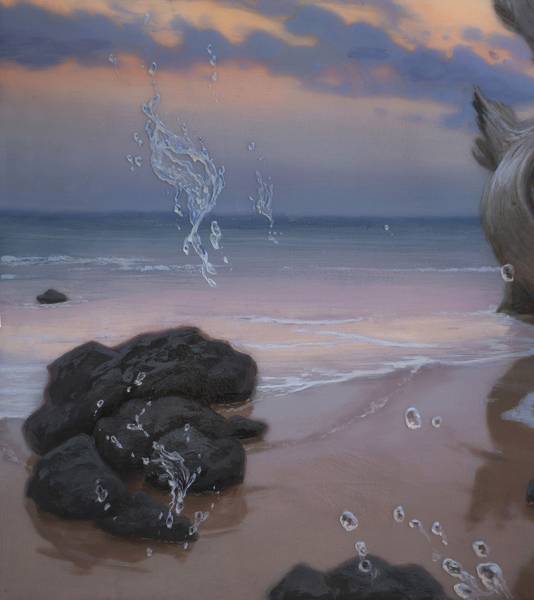
Don’t let the moisture get away!
Air Moisture
Knowing and controlling your studio air is the least frequently employed tactic and probably the most powerful. This may seem like I’m getting into the weeds, but stick with me…I’ll keep it brief!
Water vapor makes up about 1-4% of the air at sea level, and how much water the air can hold depends on its temperature and atmospheric pressure. Warmer air has a much higher capacity for water vapor. Since the water vapor potential varies, look to dew point instead of humidity for a reliable measure of air moisture.
Relative Humidity % – This is the metric most people use to discuss air moisture, but it is deceiving. It represents the relationship between how much water vapor the air currently holds vs the maximum it could hold. If it is cold, it can’t hold much! My paint dries much faster at 100% humidity in the winter (40°F/4°C) than it does at 70% in late summer (94°F/34°C)…and no wonder. In this scenario, the winter day has 6.55 ppm vs the summer day’s 26.91 ppm of water vapor in the air!
Dew Point – Reflecting the current water vapor in the air, this is the temperature the air would have to cool to, to reach 100% humidity. That may sound confusing, but all that is important to know as an artist working with water-based media is that dew point is an absolute measurement and much more useful to go off of. You can see in the maps of North America below that dew point and relative humidity tell very different stories.
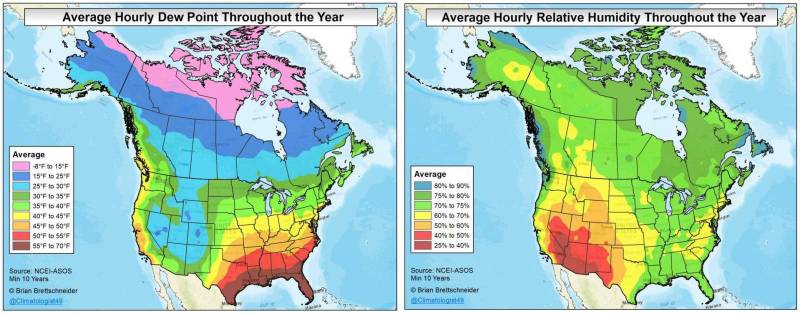
Average Dew Point and Relative Humidity maps from meteorologist Brian Brettschneider.
Air Flow – Water evaporates (or if you’re painting in under-freezing conditions, sublimates) more quickly with more air flow, so buy yourself some time by turning off your studio fan.
Why does this matter? Frankly, a lot of people already own a humidifier, and if they don’t, it’s an inexpensive studio tool that gives you control over the last piece of the dry-time puzzle. If the air is dry, I know to take extra care with my palette maintenance, choose to do more frequent isolation coats with medium to improve the impermeability of the area I’m working on, or just make the air be not-dry. If the air is humid, I can plan ahead to work on 2-3 paintings at a time, or plot my process so that I don’t work near an area I might accidentally smudge, or even (rarely) bring a hairdryer into the studio.
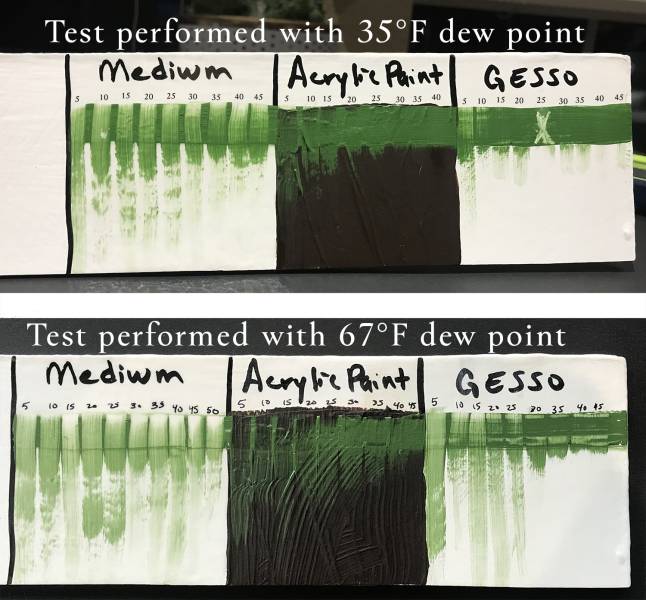
I performed the substrate test a day before a front moved in, and then erased and re-did it a few days after.
Palette Maintenance
Unlike my canvas, I need the paint on my palette to stay wet and useful for hours, days, or even weeks. If some water has already evaporated out of the mixed paint on my palette before it ever makes it onto the canvas, I’ve been robbed of precious time! Nothing feels worse than mixing a color and it drying on the palette before you get to use it…fortunately, I haven’t had to experience this in several years, and you shouldn’t have to either.
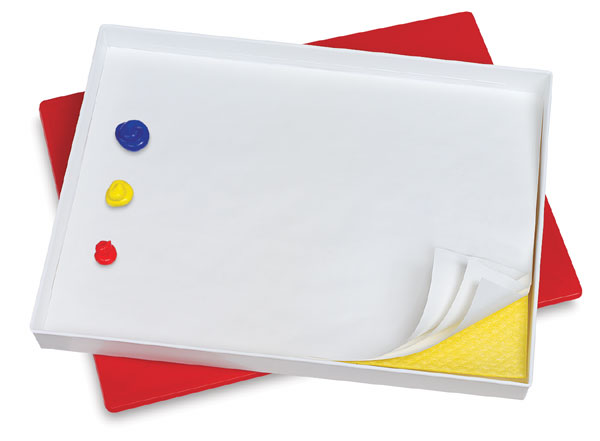
Sta-Wet Palette
Some artists swear by the Sta-Wet Palette, which puts the paint on a sheet sitting on top of a damp sponge, and closes air-tight. It works great to keep the paint perfectly fresh, but it has some big drawbacks which include the sponge molding and the excessive moisture causing the paint to run. I personally hate when my paint gets too thin.
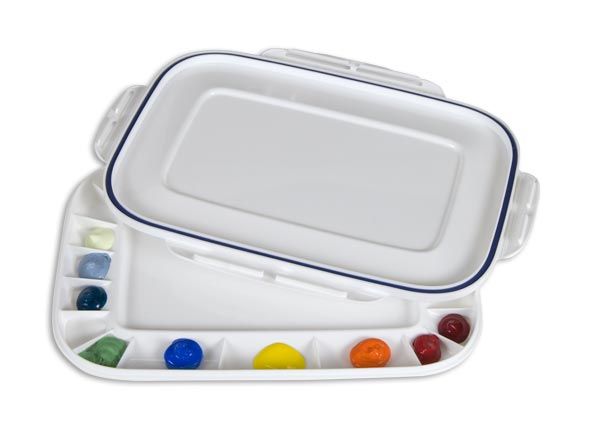
Mijello Palette
My preference is the Mijello palette, which is essentially just a food storage container (think Tupperware) with a very narrow profile. If I want paint to stay fresh for a week or more closed, I ball up a piece of paper towel, dip it in water, and nestle it in the corner to keep what air is there saturated with vapor. With good preparation, I’ve had palettes stay wet when left closed for well over a month.
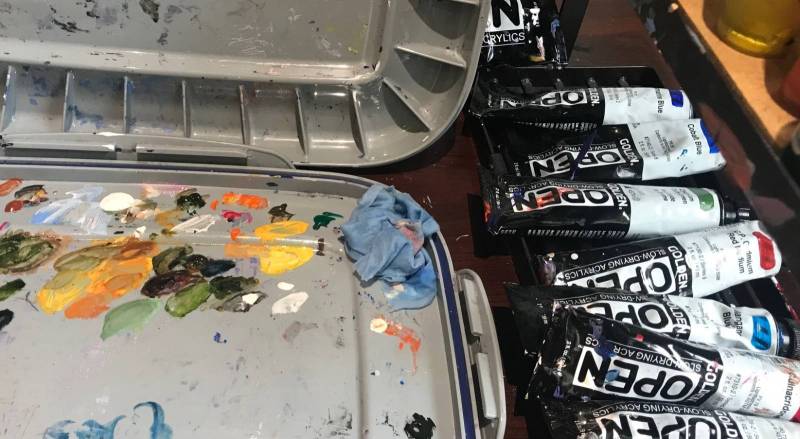
A wet clump of paper towel to keep the air inside crowded with vapor when closed
The low-profile air-tight palette keeps my paint wet over the weekend or when I leave town, but the truth is that the palette is usually open for 6+ hours straight, 5 days a week…and when it’s open, it is subject to the air in the room I paint in. I keep a spray bottle nearby and just give it a light spritz every 3-5 minutes. After not too long, it becomes like blinking…you don’t think about doing it, your hand just knows when it’s about time to give it another spray.
With all their powers combined
Most artists, when attempting to keep acrylic workable, try only the paint retarder and find that the increased working time is not enough for them. Each person’s needs from their medium differ, but I personally find that manipulating all of these factors together is more than sufficient for me. Small, thin strokes are workable for 10-20 minutes, and when I prepare to work wet-in-wet, I have at least 2-3 hours to paint a sky before things start to get tacky.
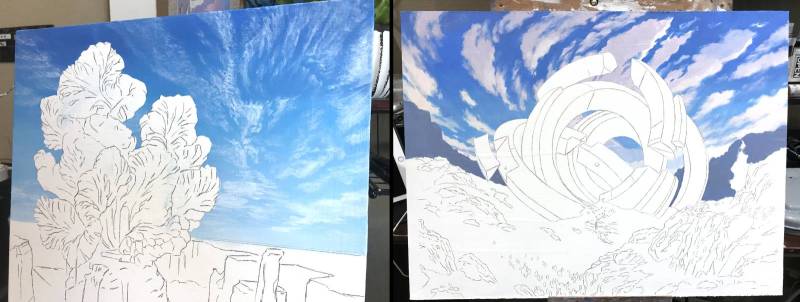
Two skies painted wet-in-wet
Next time I’ll share my process for saving a state that you can flawlessly revert back to like a digital painting, achieving that glow many attribute only to oils, and discussing/combating color shift challenges. If you have any particular questions or struggles with acrylic, let me know and perhaps we can cover it!
*Bias Notice: Acrylic paints are used in many different ways, sometimes intentionally watered down and used to beautiful effect like watercolor. I hope to provide relevant information for those who might like to work this way when talking on this subject, but it is not how I work. *


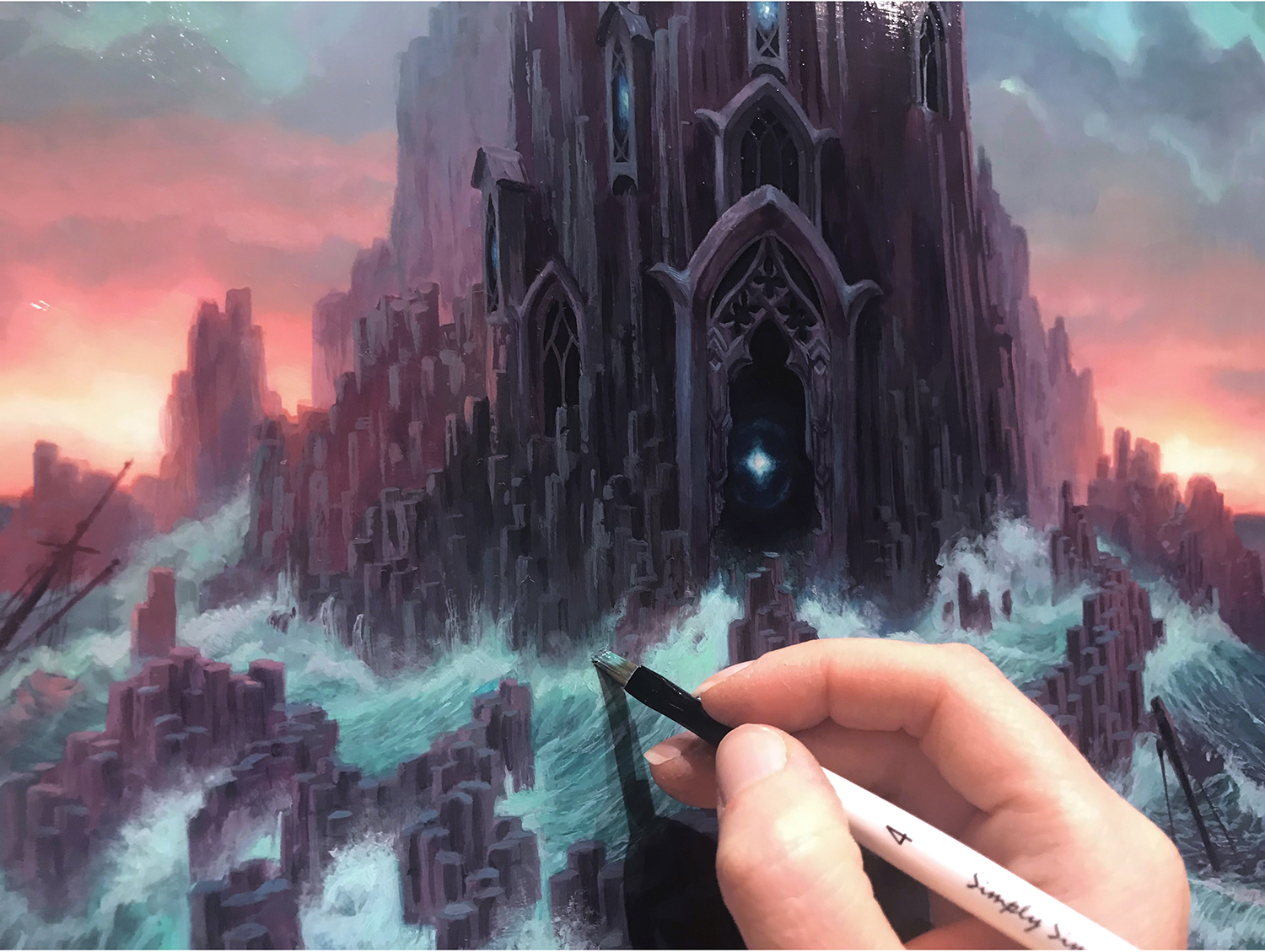




Great article Sarah. I’m fascinated how each person likes to bend their medium to suite their needs and desires. Whether its oil or acrylic, using extenders or drying accelerators to achieve a particular affect. Your process is really interesting in regards that you achieve that seamless look of oils but the open acrylics allow for a more deadline friendly application.
Thanks for the in depth materials breakdown! I’ve been planning on getting back into traditional media for some of my illustration work, and I hadn’t really considered acrylics as an option for that. You’ve definitely sold me on their viability!
Thanks so much for sharing your process, Sarah! I’ve been diving a lot more into acrylics lately and am blown away by what you achieve with them in your work!
Would you mind going into how you avoid your colors from looking chalky as an object’s form moves toward the light? This is something I can’t seem to get my head around, but your paintings on the other hand look so chromatic no matter how bright the lit side of an object becomes.
Id’ be happy to! It’s not specific to acrylics, if I’m understanding the question correctly, so I’ll have to address that separate from the acrylics series.